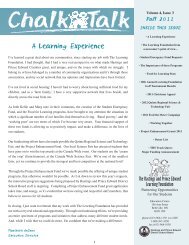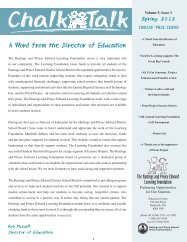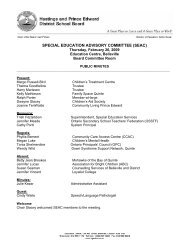Grade 11 Healthy Active Living Education Additional Supports ...
Grade 11 Healthy Active Living Education Additional Supports ...
Grade 11 Healthy Active Living Education Additional Supports ...
You also want an ePaper? Increase the reach of your titles
YUMPU automatically turns print PDFs into web optimized ePapers that Google loves.
Violence and Risk Taking Behaviour<br />
Public Profile<br />
Unit #3 Activity #5<br />
Teaching Learning Strategy #3<br />
Teacher Resource (Background Information)<br />
Catholic Profile<br />
Unit #2 Activity #2 & #3<br />
Teaching Learning Strategy N/A<br />
Instructions:<br />
1. The teacher introduces this activity by explaining the terms:<br />
Indicators of Violence:<br />
• something that demonstrates that some form of violence is occurring (e.g.,<br />
yelling, bruises, cowering, put downs, etc.)<br />
Intervention Strategies:<br />
• how to deal with the violence (e.g., counselling, hotlines, books, videos, doctors,<br />
police, etc.)<br />
Ensure students know the difference between the two terms. Distribute one card to<br />
each student with one indicator or strategy listed on it. Have each student post the<br />
card under the appropriate term. This will give the class an opportunity to review all<br />
of the indicators and strategies prior to looking at the case scenarios and all of the<br />
information will be posted in the room for them to reference throughout the activity.<br />
2. Put students in groups of four. Distribute two scenarios to each group and have them<br />
divide into partner groups to work on different scenarios. Ask each partner group to<br />
examine the case scenarios on relationship violence. Their task is to identify the<br />
indictors of violence and to develop appropriate intervention strategies to deal with<br />
the violence. Have them record their findings on the Student Resource (Worksheet-<br />
Case Scenario).<br />
3. Once the partner groups have completed the Student Resource (Worksheet- Case<br />
Scenario), ask them to pass their work to the other partner group in their foursome.<br />
The groups of two should examine the other groupsÕ answers and use the Student<br />
Resource (Peer Assessment Checklist) to provide feedback.<br />
4. Once the peer assessment is completed, groups of four should reconvene and discuss<br />
their thoughts and ideas related to the scenarios. Remind them to focus on identifying<br />
the indicators and analysing appropriate intervention strategies.<br />
5. Bring the class together for a large group discussion to develop the indicators of<br />
violence.<br />
Indicators of Violence:<br />
� abuse<br />
� desire to control behaviour, decisions, time<br />
� partner is unable to control anger or personal rage, aggressive behaviour<br />
� name calling, put-downs, belittling, humiliating, criticizing, blaming<br />
� playing mind games<br />
� controlling a persons finances (preventing them from getting a job, making the ask for<br />
money, etc)<br />
� intimidating<br />
� partner may have been abused child or witnesses parental abuse and violence<br />
<strong>Grade</strong> <strong>11</strong> <strong>Healthy</strong> <strong>Active</strong> <strong>Living</strong> <strong>Education</strong> (PPL30), Module #3 Violence and Risk Taking Behaviour<br />
Page 16
















